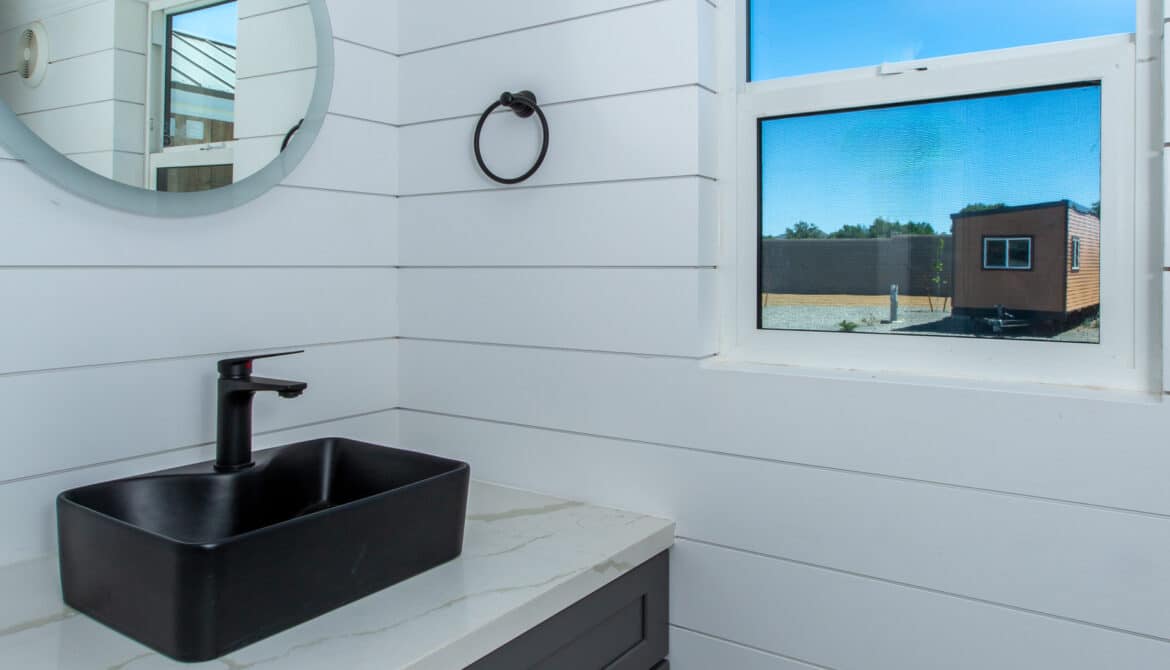Table of Contents
Tiny house water systems, integrating greywater recycling from the bathroom shower and toilet, embody the essence of compact living where efficiency is paramount and space is at a premium. The quest for freedom and flexibility in tiny homes, akin to a traditional house, demands a greywater system that works in tandem with these values, ensuring residents can thrive without the burden of excess utilities, particularly during shower use. From the benefits of reduced consumption through a greywater system to the necessity of choosing the right utilities and water tanks for your specific area, understanding how to navigate this waste water situation is crucial. Whether it’s a tiny house on wheels or a stationary abode grounded in one place, selecting an appropriate greywater system to manage water from your tiny house shower speaks volumes about your commitment to the tiny house movement—where every drop counts and every plant outside your window thrives on your thoughtful use of a sustainable plumbing system.
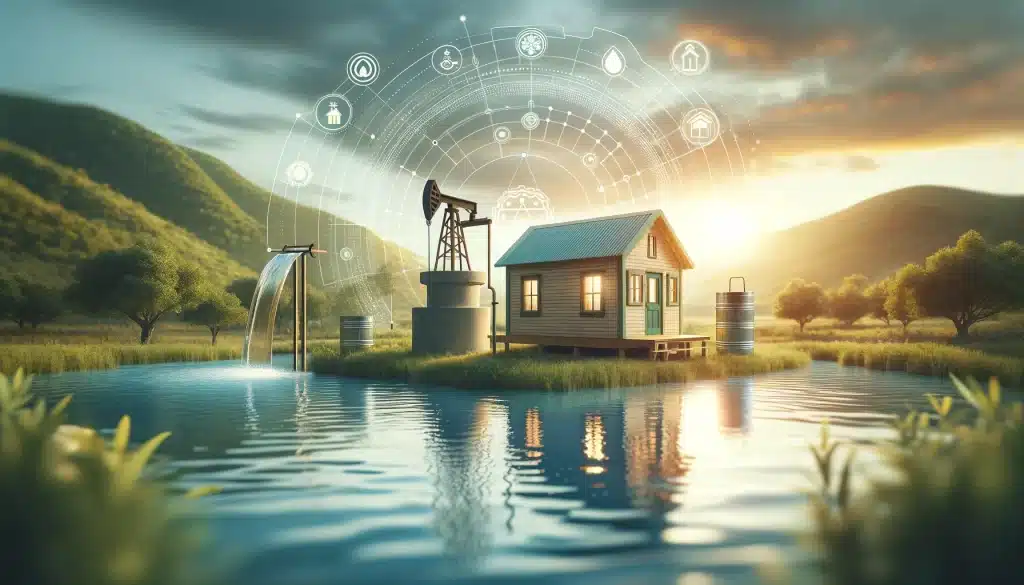
Understanding Tiny House Water Supply
Securing Your Water Source
Tiny house living requires a reliable water source. Legal considerations and risk assessments are crucial.
Access to water is a fundamental need for tiny house dwellers, often met by integrating a greywater system into their plumbing system, with efficient use of the drain and tank. Identifying sustainable sources like local wells or community systems, as well as integrating water tanks for fresh water storage and greywater recycling, is the first step in reducing waste water. It’s essential to understand the legal aspects of water rights and access, which vary by location, especially when considering a greywater system as an option for your tiny home. Ensure compliance with local regulations regarding the use of such a system and the installation of its tank. Some areas may have restrictions on collecting rainwater or tapping into natural bodies of water, making a greywater system an alternative option for a tiny home’s water tank needs.
Planning for contingencies ensures a consistent supply. Risks such as droughts or contamination can disrupt your water source, making a greywater system tank an essential option for your tiny home. Incorporating a greywater system as an option in your tiny home provides a backup plan, like stored emergency water or secondary collection methods, for added peace of mind.
Off-Grid Water Solutions
Rainwater systems are popular in tiny homes. Natural sources require filtration and purification.
Many tiny house owners opt for rainwater collection systems or greywater recycling as a sustainable option designed specifically for small spaces. These setups often include catchment areas on roofs for waste water and storage tanks for greywater, while ensuring fresh water is conserved and hot water is efficiently utilized. Water tanks provide a sustainable source of fresh water that reduces dependence on external supplies, while also allowing for the reuse of greywater and proper management of waste water.
For those situated near springs, wells, or streams, using these natural sources is an option for sourcing waste water, greywater, or even hot water. However, it’s vital to implement robust filtration and purification systems for waste water and greywater to ensure safety and health standards are met, particularly when recycling hot water.
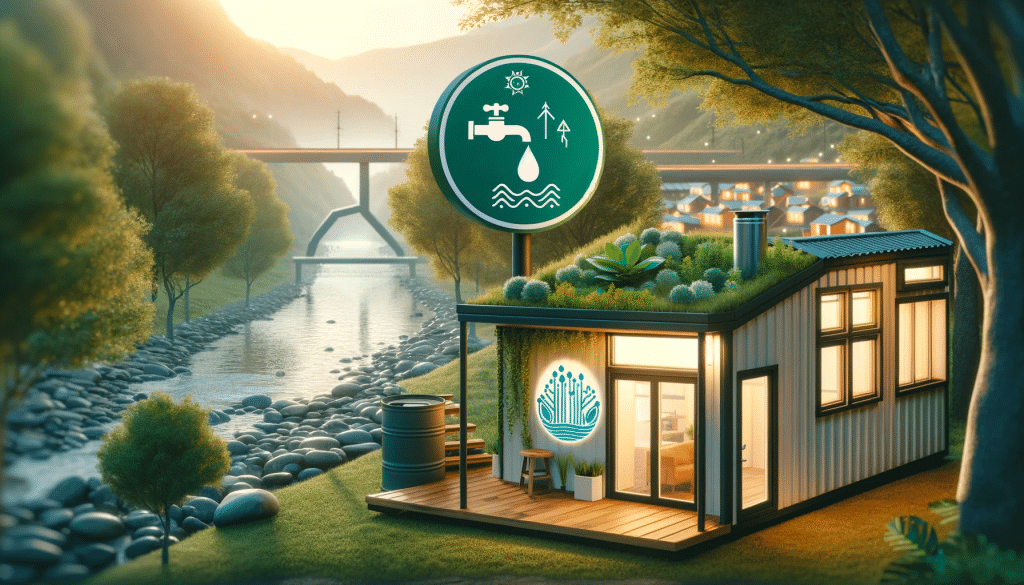
Grid Connection Options
Municipal connections offer convenience but at a cost. Weighing long-term implications is key.
Connecting to municipal water supplies provides reliability but comes with financial considerations. The costs include installation fees, monthly bills, and potential maintenance expenses over time.
Understanding the procedures for grid connection helps in making informed decisions about whether this choice aligns with one’s lifestyle goals and values concerning sustainability and independence from public utilities.
Water Utilities for Tiny Homes
Tiny homes have unique needs. This post delves into the specifics of connecting a tiny house to water services, balancing storage with hookups, and establishing permanent connections.
RV and Tiny House Hookup Methods
Connecting your tiny home to water requires careful planning. Here’s a guide to ensure a secure connection.
First, gather the necessary equipment like hoses, pressure regulators, and heat tape for cold weather. These items help prevent leaks and protect against freezing temperatures. When hooking up your tiny home, follow these steps:
- Locate the water intake valve on your tiny house.
- Connect one end of your hose to the intake valve.
- Attach the other end to the water source.
- Use a pressure regulator to avoid damage from high pressure.
- Insulate hoses and pipes if you’re in an area prone to freezing.
Remember that winter conditions demand extra precautions such as heated hoses or insulating pipes.

Combining Tank Storage with Hookup
Tank storage is essential for times when you can’t hook up directly to a water source. To manage this:
- Determine how much water you use daily.
- Choose tanks that can hold enough water based on your consumption patterns.
- Consider having both fresh and greywater tanks installed.
Switching between stored water and hookup supply should be straightforward:
- Monitor tank levels regularly.
- Refill tanks whenever possible from a hookup source.
- Use stored water when traveling or away from standard hookups.
This system ensures you always have access to clean water regardless of your location.
Establishing Permanent Connections
For those settling down in one spot, creating stable long-term connections is key:
- Check local zoning laws before attempting any permanent installations; they dictate what’s permissible.
- Employ professional techniques for robust connections that withstand time and weather changes.
Insulation strategies are crucial here too:
- Wrap pipes in foam pipe insulation or heat tape before burying them underground.
- Regularly inspect for leaks or damage especially after severe weather events.
These measures will safeguard against disruptions due to frozen or burst pipes during colder months.
Planning Tiny House Plumbing Systems
Tiny houses present unique plumbing challenges. Efficient, durable, and compact designs are essential for water systems in these small spaces.
Designing Plumbing for Compact Spaces
Maximizing space is crucial in tiny house plumbing. Innovative solutions like tankless water heaters save room and provide hot water on demand. Material choice also matters; durable options like PEX piping resist damage and take up less space than traditional materials.
Compact fixtures are a must for tiny homes. Sinks and showers designed for RVs or boats can fit better in tiny house dimensions. These often come with features that help conserve water, aligning with the eco-friendly ethos of the tiny house movement.
Implementing Plumbing in Bathrooms
Bathrooms in tiny homes require careful planning. Every inch counts, so selecting small-scale fixtures is important. A corner sink or a compact toilet can make a significant difference in saving space.
Moisture management is another key aspect. Proper ventilation helps prevent mold growth, which is a common issue due to the limited airflow in small spaces. Using moisture-resistant materials can also help mitigate this risk.
Water-saving toilets are ideal for tiny houses with limited wastewater capacity.
Composting toilets are one option that not only saves water but also reduces waste overall—a bonus for those looking to live sustainably.
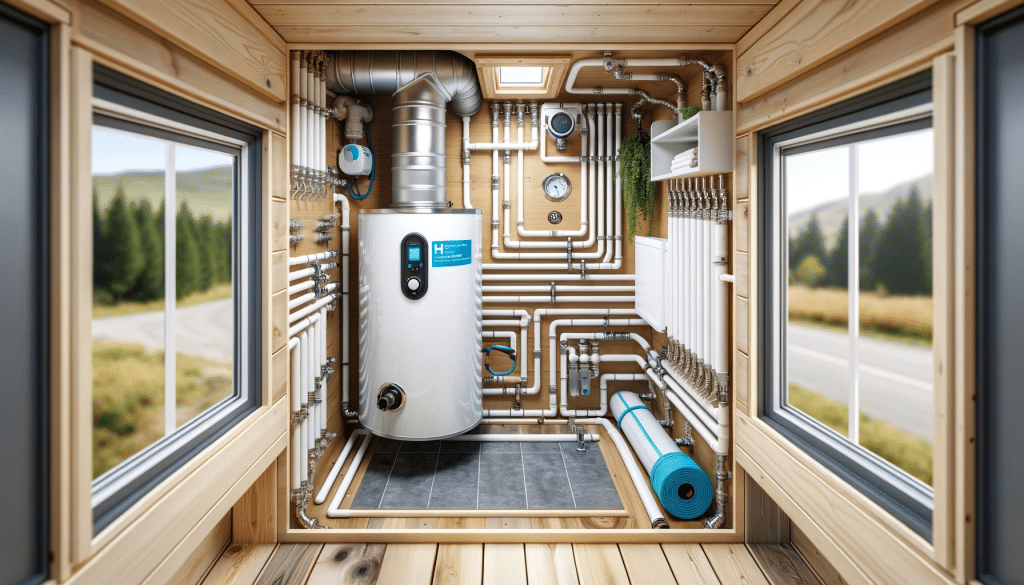
Maintaining Effective Systems
Keeping a tiny house’s plumbing system working smoothly involves regular checks. This includes inspecting connections and seals to prevent leaks, which can be more damaging in smaller spaces due to rapid spread.
Troubleshooting issues promptly helps avoid larger problems down the line. Common issues might include clogged drains or inconsistent water pressure—both of which need immediate attention in a tiny home setup.
Seasonal maintenance is particularly important to prevent system failures due to weather changes.
For example, insulating pipes can protect them from freezing during winter months, ensuring continuous access to water throughout the year.
Power Solutions for Small Dwellings
Tiny house water systems require thoughtful power solutions. Ensuring efficiency and safety is key to sustainable living.
Electrical Utility Considerations
Electrical demands heavily influence off-grid water systems. Energy-efficient pumps and heaters are vital for sustainability, reducing the overall energy footprint of tiny houses.
Safety is paramount in wet environments. Adhering to wiring safety protocols prevents hazards, ensuring a secure living space.
Exploring Various Power Sources
Solar panels offer a popular solution for powering water systems in tiny houses. They harness clean energy from the sun, minimizing reliance on traditional electricity sources. Wind turbines also present an alternative, especially in areas with consistent wind patterns.
A cost-benefit analysis is crucial when choosing power sources. Some options may have higher upfront costs but result in long-term savings and lower environmental impact. It’s important to consider the compatibility of these power solutions with mobile tiny houses which may require more flexible and portable energy systems.
Designing Optimal Systems
Customizing water systems caters to individual lifestyle needs. From daily consumption to occasional use, systems must align with personal habits and requirements.
Smart technology integration allows monitoring of usage and early detection of leaks.
This proactive approach can prevent waste and ensure efficient operation.
Strategic placement maximizes space utilization while maintaining functionality. Every square inch counts in a tiny house; thus, component layout must be carefully planned.
Water Management and Conservation
Tiny house water systems require innovative approaches for management and conservation. This post delves into effective wastewater handling, hot water solutions, and water consumption assessment.
Managing Wastewater
In tiny houses, managing wastewater efficiently is crucial to sustainability.
Greywater Recycling Methods
Greywater recycling turns waste into a resource. Techniques include using greywater for landscaping or flushing toilets. However, legalities differ across regions. Some areas embrace it; others are restrictive. Filtration is key to safe reuse. Systems range from simple sand filters to advanced biological treatments.
- Reuse in gardens reduces fresh water demand.
- Toilet flushing with greywater conserves potable water.
- Filters ensure safety before application.
Efficient Disposal Strategies
Disposing of wastewater responsibly protects the environment. Composting toilets excel by transforming waste into usable compost, cutting down blackwater production significantly. Best practices involve eco-friendly methods that prevent pollution and conserve resources.
- Composting toilets minimize blackwater creation.
- Responsible disposal methods safeguard ecosystems.
- Environmental impact stays low with careful practices.
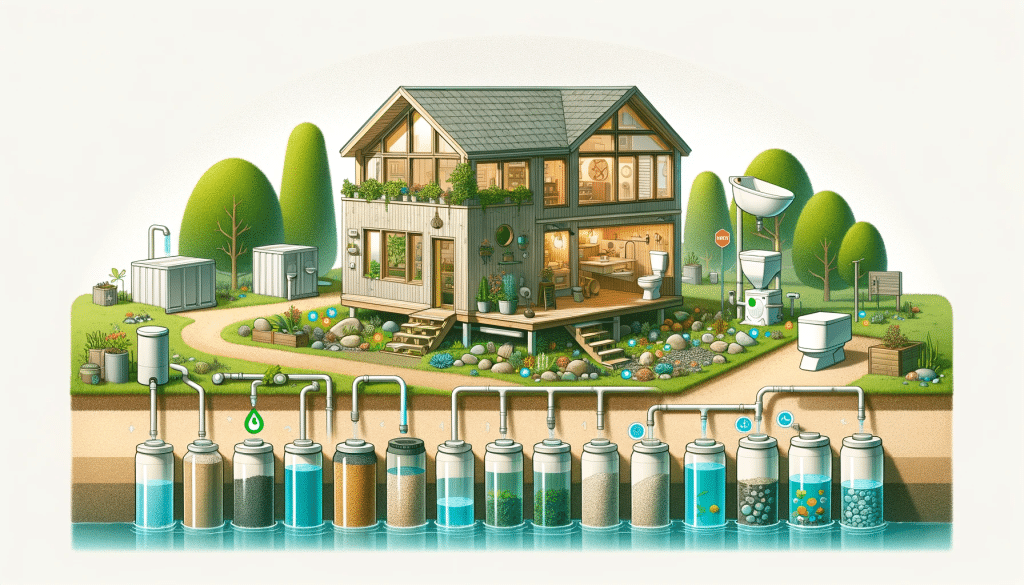
Domestic Hot Water Solutions
Hot water needs differ in small spaces compared to traditional homes.
On-demand heaters provide hot water instantly without the storage tank’s standby losses. They’re ideal for tiny house living due to their compact size and efficiency gains. Energy-efficient appliances complement these systems well, ensuring minimal energy wastage in a limited space scenario.
Installation requires careful planning:
- Space constraints dictate system choice.
- On-demand heaters save valuable room.
- Energy-efficient models cut costs over time.
Assessing Average Water Consumption
Understanding daily usage helps manage limited supplies effectively.
Calculating how much water a household uses depends on size and habits. Tools like flow meters can monitor usage patterns over time, aiding in reduction efforts. Tiny houses often use less than traditional homes due to their smaller scale and conscious design choices focused on efficiency.
Tracking tools highlight usage trends:
- Daily needs vary per household activity level.
- Monitoring aids in identifying excessive use areas.
- Tiny houses typically consume less than larger homes.
Wastewater Treatment in Tiny Houses
Tiny houses present unique challenges and opportunities for wastewater treatment. This section delves into effective greywater management, the intricacies of plumbing mechanics, and the essentials of system design and maintenance.
Greywater Management Techniques
Tiny house enthusiasts can adopt simple DIY greywater systems. These are perfect for beginners who want to manage water efficiently. For those more experienced, advanced setups with filtration can reuse water safely. Health is paramount; residents must take precautions when dealing with greywater in small spaces.
Greywater systems range from basic to complex. Beginners often use a straightforward approach like bucketing or using a hose to redirect water for irrigation. More advanced systems may include filters and pumps that allow for water reuse within the home itself. These setups require careful planning but offer greater sustainability.
Health risks are an important consideration in tiny houses due to limited space. Greywater can contain bacteria and chemicals harmful if not handled properly. It’s critical to ensure that any system prevents contact with drinking water and food preparation areas.
Detailed Examination of Plumbing Mechanics
Understanding plumbing mechanics is crucial in tiny houses where space is at a premium. Pipe sizing, pressure requirements, and flow rates must be carefully calculated to ensure efficiency without sacrificing functionality.
The compact nature of tiny house plumbing calls for precision in choosing valves, joints, and fittings. The right selections prevent leaks while maximizing space utilization.
Preventive measures against leaks, clogs, and corrosion extend the life of your plumbing system significantly. Regular inspections help identify potential problems before they escalate into major issues.
Greywater System Design and Maintenance
Designing a greywater system requires thoughtful layout planning. It should separate greywater from blackwater easily while considering the tiny house’s spatial constraints.
Regular cleaning routines play a pivotal role in maintaining a healthy greywater system over time. Without proper upkeep, systems can become inefficient or even hazardous.
Recognizing signs of needed maintenance helps avoid costly overhauls later on. Indicators include slow drainage, unpleasant odors, or changes in plant health when used for irrigation.
Adapting to Limited Water Resources
Tiny houses often face water challenges. This article explores solutions for efficient water use and storage.
Strategies Without Direct Source
Portable water solutions like jugs or bladders are essential when fixed sources are scarce. Conservation becomes crucial with limited supplies. Emergency plans must include rationing guidelines to ensure sustainability.
Carrying in water requires careful planning. Residents often need to calculate daily usage meticulously, ensuring they don’t run out before the next refill opportunity. Portable tanks can be a lifeline, but they also demand a commitment to strict conservation methods.
In emergencies, having clear guidelines helps manage the scarce resource.
Rationing isn’t just about drinking water; it’s about reducing consumption across all activities, from cooking to cleaning.
Utilizing Tanks for Storage
Choosing the right tank size is influenced by available space and usage needs. Placement decisions impact convenience and system efficiency—inside for accessibility or outside to save interior space.
Insulation is key for temperature control, preventing freezing in cold climates or algae growth in warm ones. The right insulation can extend the lifespan of your stored water and reduce maintenance needs.
Tanks range from small containers fitting under a sink to large barrels occupying significant exterior space. The choice depends on individual lifestyles and how much one can feasibly conserve day-to-day.
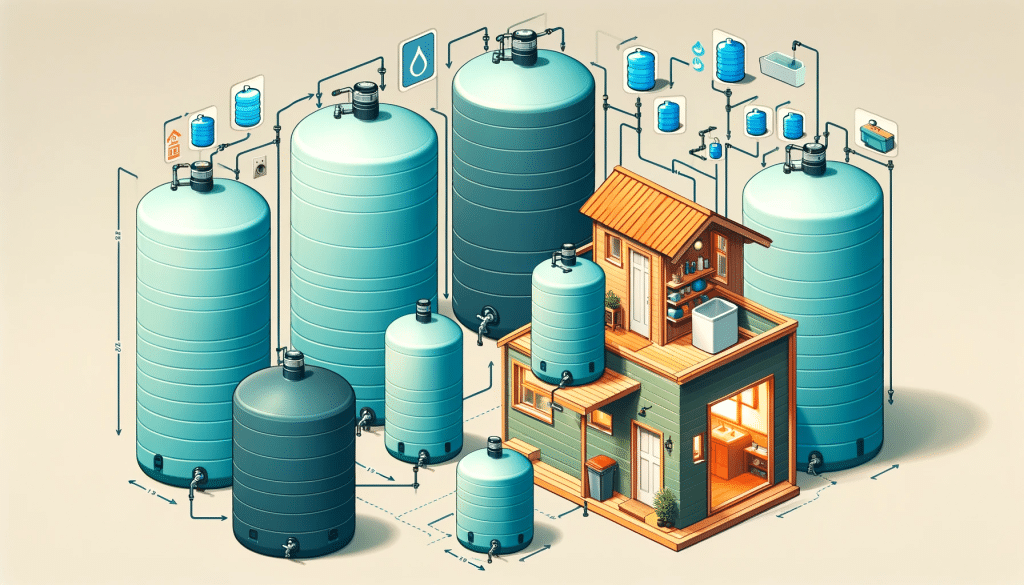
Selecting Water Source
Lifestyle choices dictate the type of water source tiny house dwellers will use. Frequent travelers might prefer portable options, while stationary residents could invest in more permanent solutions.
Source reliability should match personal risk tolerance levels—some may be comfortable with less reliable but natural sources; others may prioritize constant access over cost or environmental impact considerations.
Community resources offer part-time solutions that blend independence with communal support—a shared well or a refill station can ease the burden of individual supply management.
Overview of Water Systems
Comparing traditional systems with innovative tiny house setups reveals differences in scale, complexity, and sustainability features. Visual diagrams help explain how these compact systems fit into small spaces.
Every system should include key components: intake method, storage solution, filtration process, and distribution mechanism—each tailored to specific tiny house constraints and owner preferences.
Traditional plumbing might involve extensive networks of pipes; tiny house systems simplify this drastically without compromising function or comfort levels within the living space.
Preparing Your House Setup
Site preparation involves assessing land characteristics before installing a water system—consider slope, soil type, climate conditions, and potential natural disasters like flooding or droughts.
Challenges related to climate could mean additional insulation for pipes or elevated platforms for tanks in flood-prone areas—the goal is always minimizing environmental risks through smart design choices.
Comprehensive Overview of Systems
Overview of Tiny House Water Systems
Tiny houses often need unique water systems. These systems must be efficient and compact to fit the small space. They include sources for clean water, ways to heat it, and methods to get rid of waste.
Most tiny homes use a combination of public utilities and off-grid solutions.
Some connect directly to city water for reliability. Others collect rainwater or use wells for independence.
The size of the water tank is vital in a tiny house system. It must be big enough to store sufficient water but small enough to save space. A balance between capacity and practicality is essential.
Water heaters are another critical component. Compact on-demand heaters are popular as they save energy and space.
Preparing Your House Setup
Setting up your tiny house’s water system requires careful planning. You should decide on the source of your water early in the design process.
If using city water, ensure you have access and permission. For off-grid sources, consider the climate and environment for rainwater collection or well drilling.
The location of your tiny house affects the setup too. Cold climates may require insulated pipes to prevent freezing.
Plan where each part of your system will go before building begins. This includes tanks, heaters, filters, pumps, and plumbing lines.
Think about future maintenance when designing your system layout. Make sure that components are easily accessible for repairs or replacements.
Common Practices in Plumbing Choices
In plumbing choices for tiny houses, durability matters a lot. PEX piping is common due to its flexibility and resistance to freezing temperatures.
Simple systems with fewer connections reduce leak risks. They also make maintenance easier over time.
Greywater systems are gaining popularity in tiny homes. They recycle sink and shower water for toilets or gardening, saving fresh water resources.
For waste disposal, composting toilets are a common choice due to their low impact on the environment.
High-quality fixtures can prevent problems later on despite their higher upfront cost.
Conclusion
The intricacies of water supply, plumbing, power solutions, and wastewater treatment constitute the backbone of sustainable living in tiny houses. This article has navigated through the various aspects essential for homeowners to understand and manage their water resources effectively. Emphasis on conservation and adapting to limited resources underscores the importance of meticulous planning and implementation of water systems in these compact dwellings. The collective insights presented herein serve as a guide to achieving self-sufficiency and ecological responsibility within the unique constraints of tiny house living.
Readers are encouraged to reflect on these considerations and take proactive steps towards optimizing their tiny home water systems. By embracing the principles outlined, individuals can contribute to a greener future while enjoying the freedom and simplicity that tiny house living offers. Act now to ensure your tiny home is not only a place of comfort but also a beacon of sustainability.
FAQs
Common water sources for tiny houses include municipal supply, well water, rainwater, and surface water. Each has advantages and disadvantages based on location and regulations.
How can water be stored effectively and efficiently in a tiny house, considering limited space?
Effective water storage in tiny houses involves utilizing compact tanks, underfloor storage, or wall-mounted systems to optimize space while ensuring adequate supply.
What are the best water conservation techniques suitable for tiny homes?
Best water conservation techniques for tiny homes include low-flow fixtures, greywater recycling, rainwater harvesting, and efficient appliances.
What key factors should be considered when designing a water system for a tiny house?
Key factors when designing a tiny house water system include source reliability, water quality, space optimization, and sustainability.
Select equipment based on tiny house needs by considering water source availability, space constraints, and the desired level of automation and energy efficiency.
Can water systems in tiny houses be integrated with other home systems, and how?
Water systems in tiny houses can integrate with other home systems through shared plumbing and smart technology, allowing for efficient use and monitoring of water alongside electricity and heating.
What innovative methods are available for collecting water in a tiny house setting?
Innovative methods for collecting water in tiny houses include compact rainwater collection systems, off-grid well drilling, and portable water purification devices.
The typical cost range for a tiny house water system, including components like pumps, tanks, filters, and plumbing, can range from $1,000 to $5,000 or more.
Certain tiny house water systems can lead to long-term savings by using low-flow fixtures, rainwater harvesting, and greywater recycling. Factors include local water costs and initial setup expenses.
DIY installation can be cost-effective but requires skill and time. Professional installation ensures compliance with local codes but may be more expensive.
What recent technological advancements have been made in water systems for tiny houses?
Recent technological advancements in tiny house water systems include smart meters, efficient water heaters, and compact greywater treatment systems.
How do smart monitoring systems enhance the management of water usage in tiny houses?
Smart monitoring systems enhance water management by tracking consumption, detecting leaks, and allowing remote control of fixtures and appliances, promoting efficient usage.
Energy-efficient appliances suitable for tiny houses include tankless water heaters, compact washing machines, and energy-star rated fixtures, all designed to maximize space and resource efficiency.
Sustainable materials and practices like water-efficient fixtures and eco-friendly plumbing materials reduce waste, energy consumption, and environmental impact in tiny house water systems.
Consider water source, usage patterns, and available space when designing a tiny house water system. Prioritize efficiency and sustainability.

